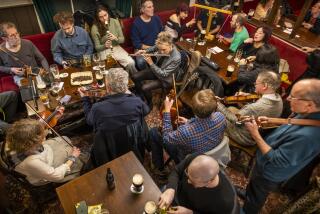British Seek Bigger Share of U.S. Spirits Market : London Firm’s Expected Liquor Barn Deal Would Provide Entry Into North American Retail Sales
- Share via
The Red Coats may have yielded to blue blazers and club ties, but the British are indeed coming--having invested more than $6 billion in the last year to get a solid foothold in the North American spirits and wine business.
The most recent evidence is the expected sale of Safeway’s 104 Liquor Barn outlets in California and Arizona to Majestic Wine Warehouses in London. Though neither company would confirm the sale, industry sources maintain that a “letter of intent” was signed last week and put the price at about $103 million.
Majestic’s chairman, Giles Clark, declined to comment on the reported sale, as did Safeway. Clark described his firm as Britain’s largest privately held retailer of wine and spirits. It has 21 outlets--seven in London.
If consummated, the deal would mark the first entry of the British wine and spirits industry at the retail level. Until now, the major moves have been in manufacturing alcoholic beverages.
When the Buying Began
The “invasion” began inauspiciously enough in 1982, when Whitbread brewery acquired a U.S. wine-and-spirits importer, Julius Wile Sons, for $155 million. It took another step last year in buying, with Italian and French partners, a 1,100-acre spread in Napa County for development of vineyards and a winery.
Last May, Guinness, another brewery giant, spent $4 billion to acquire Distillers Co., which aside from being Britain’s largest manufacturer of Scotch, markets such leading brands as Dewar’s, Black & White and Johnnie Walker in this country.
Allied-Lyons was next, buying a 51% stake in Hiram Walker’s wine and spirits division last fall. Then in March, London-based Grand Metropolitan completed its purchase of Heublein from RJR Nabisco for $1.2 billion and tossed in another $128 million to take over Heublein’s recently acquired Almaden Vineyards in California. Heublein alone controls 11% of the U.S. alcoholic-beverage market.
The Liquor Barn--Majestic Wine deal would seem to build upon the earlier acquisitions, observed Paul Gillette, Los Angeles publisher of the Wine Investor and other beverage publications. “It makes excellent sense--especially in view of the trend among United Kingdom beverage companies to establish beachheads in the U.S.”
Gillette and other close observers of the U.S. wine and spirits trade suspect that the well-established British beverage giants are capitalizing on a weaker dollar in relation to the pound as well as the disenchantment of consumer-product conglomerates with the liquor business they have acquired over the last decade or so.
“It’s almost like currency trading,” Gillette said.
In the bidding for Liquor Barn, which Safeway put on the block in early April, the exchange rate may have tipped the balance in favor of the British concern over the three groups of American investors competing for the 105-store chain. These losing bids reportedly were in the “mid-90s” while Majestic’s just topped $100 million.
Opportunity Called
But if current exchange rates facilitate the acquisitions, the fact that liquor sales have flattened out in the 1980s appears to have chilled the ardor of such U.S. consumer-product conglomerates as RJR Nabisco for their spirits properties, said Bill Slone, director of the Beverage Network in New York.
“The British saw a situation that was ripe for them,” Slone said. “They concluded that in the long run these properties represent a good investment.”
Steven Boone, an industry consultant who helped Safeway launch Liquor Barn and was among the groups bidding for it, said the British may also be motivated by the simple desire to survive in a globally shrinking market. “It’s either get bigger or get out,” Boone said.
(Boone, too, declined to comment on the Liquor Barn bidding.)
In Safeway’s case, Kohlberg Kravis Roberts & Co., the private investment-banking firm that bought it last summer for $4.1 billion, has been selling off parts of what was the nation’s largest chain of supermarkets in order to slash its heavy debt.
The beverage retailer, which reported sales of about $330 million in 1986, has 86 outlets in California, 18 in Arizona and 1 in Louisiana. Slone described the Safeway unit as the nation’s largest liquor retailer in terms of volume. “It has an 18% share of the retail wine and spirits market in Northern California, a 9% share in Southern California and 20% in Arizona,” he said.
More to Read
Inside the business of entertainment
The Wide Shot brings you news, analysis and insights on everything from streaming wars to production — and what it all means for the future.
You may occasionally receive promotional content from the Los Angeles Times.










